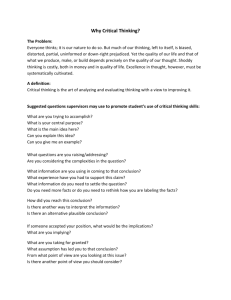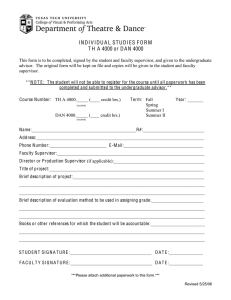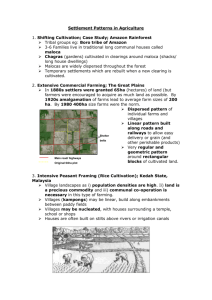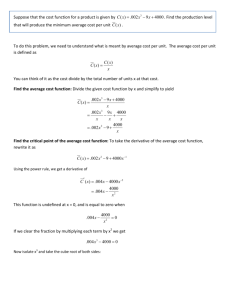Advance Journal of Food Science and Technology 10(2): 122-126, 2016
advertisement
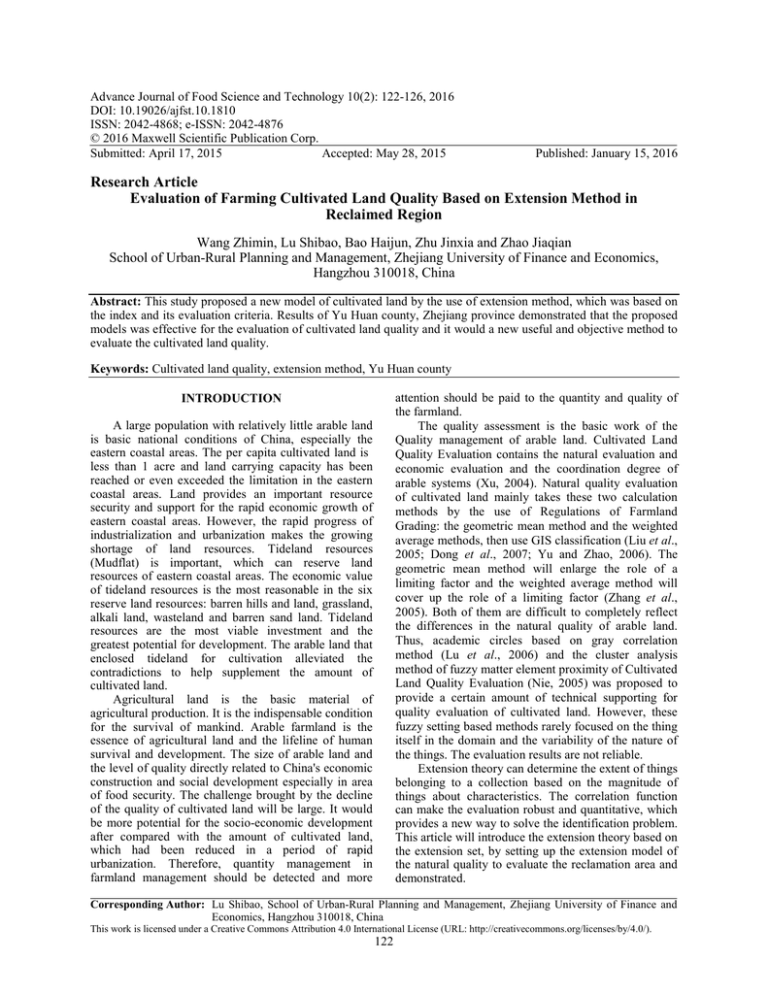
Advance Journal of Food Science and Technology 10(2): 122-126, 2016
DOI: 10.19026/ajfst.10.1810
ISSN: 2042-4868; e-ISSN: 2042-4876
© 2016 Maxwell Scientific Publication Corp.
Submitted: April 17, 2015
Accepted: May 28, 2015
Published: January 15, 2016
Research Article
Evaluation of Farming Cultivated Land Quality Based on Extension Method in
Reclaimed Region
Wang Zhimin, Lu Shibao, Bao Haijun, Zhu Jinxia and Zhao Jiaqian
School of Urban-Rural Planning and Management, Zhejiang University of Finance and Economics,
Hangzhou 310018, China
Abstract: This study proposed a new model of cultivated land by the use of extension method, which was based on
the index and its evaluation criteria. Results of Yu Huan county, Zhejiang province demonstrated that the proposed
models was effective for the evaluation of cultivated land quality and it would a new useful and objective method to
evaluate the cultivated land quality.
Keywords: Cultivated land quality, extension method, Yu Huan county
attention should be paid to the quantity and quality of
the farmland.
The quality assessment is the basic work of the
Quality management of arable land. Cultivated Land
Quality Evaluation contains the natural evaluation and
economic evaluation and the coordination degree of
arable systems (Xu, 2004). Natural quality evaluation
of cultivated land mainly takes these two calculation
methods by the use of Regulations of Farmland
Grading: the geometric mean method and the weighted
average methods, then use GIS classification (Liu et al.,
2005; Dong et al., 2007; Yu and Zhao, 2006). The
geometric mean method will enlarge the role of a
limiting factor and the weighted average method will
cover up the role of a limiting factor (Zhang et al.,
2005). Both of them are difficult to completely reflect
the differences in the natural quality of arable land.
Thus, academic circles based on gray correlation
method (Lu et al., 2006) and the cluster analysis
method of fuzzy matter element proximity of Cultivated
Land Quality Evaluation (Nie, 2005) was proposed to
provide a certain amount of technical supporting for
quality evaluation of cultivated land. However, these
fuzzy setting based methods rarely focused on the thing
itself in the domain and the variability of the nature of
the things. The evaluation results are not reliable.
Extension theory can determine the extent of things
belonging to a collection based on the magnitude of
things about characteristics. The correlation function
can make the evaluation robust and quantitative, which
provides a new way to solve the identification problem.
This article will introduce the extension theory based on
the extension set, by setting up the extension model of
the natural quality to evaluate the reclamation area and
demonstrated.
INTRODUCTION
A large population with relatively little arable land
is basic national conditions of China, especially the
eastern coastal areas. The per capita cultivated land is
less than 1 acre and land carrying capacity has been
reached or even exceeded the limitation in the eastern
coastal areas. Land provides an important resource
security and support for the rapid economic growth of
eastern coastal areas. However, the rapid progress of
industrialization and urbanization makes the growing
shortage of land resources. Tideland resources
(Mudflat) is important, which can reserve land
resources of eastern coastal areas. The economic value
of tideland resources is the most reasonable in the six
reserve land resources: barren hills and land, grassland,
alkali land, wasteland and barren sand land. Tideland
resources are the most viable investment and the
greatest potential for development. The arable land that
enclosed tideland for cultivation alleviated the
contradictions to help supplement the amount of
cultivated land.
Agricultural land is the basic material of
agricultural production. It is the indispensable condition
for the survival of mankind. Arable farmland is the
essence of agricultural land and the lifeline of human
survival and development. The size of arable land and
the level of quality directly related to China's economic
construction and social development especially in area
of food security. The challenge brought by the decline
of the quality of cultivated land will be large. It would
be more potential for the socio-economic development
after compared with the amount of cultivated land,
which had been reduced in a period of rapid
urbanization. Therefore, quantity management in
farmland management should be detected and more
Corresponding Author: Lu Shibao, School of Urban-Rural Planning and Management, Zhejiang University of Finance and
Economics, Hangzhou 310018, China
This work is licensed under a Creative Commons Attribution 4.0 International License (URL: http://creativecommons.org/licenses/by/4.0/).
122
Adv. J. Food Sci. Technol., 10(2): 122-126, 2016
Extension set theory: To quantify the problem-solving
process, extension theory is used to establish the
corresponding mathematical tool.
Definition 3 Let U be the domain of discourse, if
U defined in any one element u, have a
corresponding real number K (u) ∈ (-∞,+∞) you called
,
A= {(u,y) u ∈ U, y = K(u) ∈ (−∞, +∞)} is a extension set of
Extension theory: The Extension Theory was founded
by Tsai et al. (1997) Chinese scholars. It focuses on the
rules and methods by the formal tools to solve the
problem of contradictions from the point view of the
qualitative and quantitative research (Tsai et al., 1997).
Extension theory mainly includes matter-element
theory and extension set theory and its logic cell is
matter-element.
the domain of discourse Where in y = K (u) is the
correlation function of A, K (u) is the degree of
association for extension set A.
Matter element theory: In order to describe the
process of changing of the objective things and making
the process to solve the contradiction problem of
formalization, extenics introduced the concept of
matter-element as the basic elements to describe things.
Definition 1 defines the things name N, the
magnitude of the characteristic c is v, we use an ordered
triad R = (N, c, v) as the basic element for describing
things, called matter-element, where N represents the
matter; c, the characteristics; v is the N’s.
Definition 2 A thing can have multiple
characteristics, if things can be described by n features
c1, c2, ..., cn and the magnitude corresponding to v1,
v2,..., vn then:
N , c1 ,
c2 ,
R=
M
cn ,
THE NATURAL QUALITY EVALUATION
OF RECLAMATION AREA ON
EXTENSION METHOD
Factor index system and evaluation criteria: The
natural quality evaluation of reclamation area involves
many influencing factors, the prerequisite and basis of
the quality evaluation was setting up the index system
that can reflect and measure the block comprehensively.
The evaluation factors were selected according to the
Delphi method, which was in accordance with the
system of comprehensive, scientific, comparability and
operability requirements. The index system was
composed by 7 indicators. These seven indicators are
foundation soil fertility, soil texture, organic matter,
plow layer thickness, irrigation, elevation and drainage
(Table 1). The rating criteria of indicators determined
by the Delphi method are shown in Table 2.
The minimum polygon formed by few maps (Soil
maps, land use map and administrative maps) overlap
as evaluation unit. The evaluation unit thus formed had
clear space boundaries and administrative affiliation,
accurate area and landform types, soil types, land use
patterns and farming methods are basically the same.
Then score of each evaluation unit was calculated based
on the collected data and field surveys.
v1 R 1
v 2 R 2
=
M M
vn R n
The above formula is n-dimensional matterelement. Where in Ri = (N, ci, vi) is called sub-matter
element of R, C = [c1, c2,..., cn ] is a feature vector,
V = [v1, v2, ..., vn] is the magnitude corresponding to
feature vector.
Table 1: The evaluation index of cultivated land quality in Yu Huan county
Indicators number
C1
C2
C3
Indicators name
Basic fertile
Soil texture
Organic matter
C4
Plow layer thickness
Table 2: The criteria of evaluation index of cultivated land quality in Yu Huan county
Quality
Plow layer
scores
Basic fertile
Soil texture
Organic matter thickness
100
Loam
≧80
≧3
≧20
95
18-20
90
Silt loam\clay loam
2.5-3.0
15-18
85
70-80
80
The soil clays\sandy loam
2.0-2.5
75
70
60-70
1.5-2.0
10-15
65
60
Clay
1.0-1.5
55
50-60
50
<10
45
40
Sand
0.5-1.0
35
40-50
30
20
<0.5
15
<40
10
123
C5
Irrigation
Irrigation
≧70
C6
Altitude
Altitude
≦10
10-50
50-150
C7
Drainage
Drainage
≧10
5-10
50-70
150-300
300-500
3-5
30-50
500-800
<30
800-1000
>1000
<3
Adv. J. Food Sci. Technol., 10(2): 122-126, 2016
Table 3: The weights of the evaluation index of cultivated land quality in Yu Huan county
Evaluation index
Basic fertile
Soil texture
Organic matter
Plow layer thickness
Weights
0.25
0.1
0.15
0.1
Nt
R 0t =
The extension model of natural quality evaluation of
cultivated land of reclamation area:
Construction of the same intrinsic matter element
model: N-dimensional with intrinsic material element
model of the cultivated land evaluation unit according
to the matter-element theory is as follows:
Ni,
R i = (N i ,C,Vi ) =
C1 ,
C2,
M
Cn ,
V1i
V2i
i = 1, 2, L n
M
Vni
R p = [ P,
C,
C1
C2
M
Cn
<0,100>
<0,100>
M
<0,100>
Determination of the weight coefficient of pending
matter element and index: The score results obtained
was in accordance with the evaluation index of the
pending evaluation unit Q, which was represented by
matter element:
Gm
<a1m ,b1m >
M
M
L <a nm ,bnm >
L
q
L
R0 is the same matter-element body of the same
intrinsic matter-element R1, R2, ... Rm, where Gj
represents evaluation category j, Ci represents
indicators i, Vij = <aij, bij> is the value range
predetermined by Nj about Ci, that is the classic domain
of data range of the corresponding indicators on each of
the categories.
Let,
P
Vp]=
C3
C4
Drainage
0.1
X t1
X t2
t= 1 ,2 ,3 ,4
X t3
X t4
P C1
C2
Rp= [ P, C, Vp ] =
M
C
20
Determination of the classical domain and section
domain:
G1,
G2
N
G1 G2 L Gm C1 <a11,b11 > <a12 ,b12 >
=
V1 V2 L Vm M
M
M
Cn <a n1,bn1 > <a n2 ,bn2 >
C1
C2
Altitude
0.1
In the above formula Nt represents the evaluation
unit level, when t = 1, 2, 3, 4, Nt respectively level 1, 2,
3 and 4, respectively. Xt1, Xt2, Xt3, Xt4 represents the
magnitude of the range specified in the corresponding
feature about Nt, when t = 1, 2, 3, 4, the scope of its
magnitude is <75, 100>, <50, 75>, <25, 50>, <0, 25>
respectively.
Setting section domain in this example is:
In the above formula Ni represents the ith
evaluation units of arable land; C1, C2, ..., Cn, represents
the main features of the natural quality of the evaluation
unit (the evaluation index), such as the basis of fertility,
soil texture, organic matter, the plow layer thickness,
irrigation, elevation and drainage; Vli, V2i, ..., VnI
represents a magnitude which evaluation unit i
correspond to Cj (j = 1, 2, ..., n).
N
R0 =
C
Irrigation
0.2
C1 V1
C2 V2
M M
Cn Vn
calling pending matter element of q.
Vi is the magnitude of q for the evaluation Ci, in
other words q is the index score.
The weight coefficient of the arable land natural
quality was set up using the Delphi method. The
evaluation factors indicators Ci of Yu Huan reclamation
area is ai and T = 1, shown in Table 3.
Calculation of the degree of association of the
evaluation: Establish the correlation function of the
evaluation unit q on level j as follows:
V 1p =<a 1p ,b 1p >
V 2p =<a 2p ,b 2p >
M
V np =<a np ,b np >
-ρ(v i,V ij)
V ij
K j (v i ) =
ρ(v i,V ij)
ρ(v i,V ip )-ρ(v i,V ij)
where,
P = All categories
Vip = The magnitude range taken by P about Ci
P = Section domain and Vij<VIP (i = 1, 2, ... and n;
j = 1, 2, ..., m)
v i ∈ [a ij,b ij]
v i ∉ [a ij,b ij]
Among them:
In this case, the classic domain of each indicators
of the evaluation unit is:
ρ(vi,V ij)=ρ(v i,<a ij ,b ij >)= v i-
124
a ij+b ij b ij-aij
2
2
Adv. J. Food Sci. Technol., 10(2): 122-126, 2016
Table 4: Scores of the evaluation index of each project
Evaluation index
------------------------------------------------------------C2
C3
C4
C5
Evaluate on unit C1
q1
72
70
65
45
75
q2
60
55
85
75
80
q3
35
45
30
55
75
q4
40
35
20
30
25
q5
50
55
35
40
20
q1
72
70
65
45
75
q2
60
55
85
75
80
Calculate Level
evaluation unit q:
m
*
m
-
j= ∑ jK j(q)
variable
the
-
j
j=1
among them:
-
K j(q)=
Kj(q)- minKj(q)
j
maxKj(q) - minKj(q)
j
aip+b ip bip-aip
2
2
j
The level variable eigenvalues reflect the deviation
degree of the level j0 of the evaluation unit q tend to the
other categories.
Calculation of matter element based on
comprehensive correlation degree: According to the
degree of association on level j, which was determined
by weight coefficient ai of indicator Ci and each
evaluation of evaluation unit q, the comprehensive
correlation degree of pending matter element was
calculated as Kj (q) = ( ).
Case study: Five evaluation units of Yu Huan were
used to test the proposed extensive comprehensive
evaluation model. According to Table 1 and 2, scores
these five evaluation unit of the various factor index,
the results are demonstrated in Table 4.
The correlation about level j of the various factor
index of these five evaluation unit was calculated based
on the correlation function of the above established
evaluation unit q and the evaluation index about j, the
results are shown in Table 5.
Five units evaluation results was obtained by the
calculation of the weight of each evaluation value,
which was based on the comprehensive correlation
Rating: Comparing the size of each level associated
degrees to determine the results of the assessment. The
degree of association of the level j greater, which
indicates that the evaluation unit q compliance this level
set was good. If
is belong to level j0.
of
∑ K (q)
j=1
v ij = b ij -a ij
ρ(vi,V ip)=ρ(vi,<a ip ,b ip >)= vi-
eigenvalue
, the evaluation unit q
Table 5: Correlation values of K (v) about the level j for each evaluation index of the evaluated projects
v1
v2
v3
v4
v5
K1 (vi)
q1
-0.0968
-0.1429
-0.2222
-0.4000
0.0000
q2
-0.2727
-0.3077
0.4000
0.0000
0.2000
q3
-0.5333
-0.4000
-0.6000
-0.3077
0.0000
q4
-0.4667
-0.5333
-0.7333
-0.6000
-0.6667
q5
-0.3333
-0.3077
-0.5333
-0.4667
-0.7333
K2 (vi)
q1
0.1200
0.2000
0.4000
-0.1000
0.0000
q2
0.4000
0.2000
-0.4000
0.0000
-0.2000
q3
-0.3000
-0.1000
-0.4000
0.2000
0.0000
q4
-0.2000
-0.3000
-0.6000
-0.4000
-0.5000
q5
0.0000
0.2000
-0.3000
-0.2000
-0.6000
K3 (vi)
q1
-0.4400
-0.4000
-0.3000
0.2000
-0.5000
q2
-0.2000
-0.1000
-0.7000
-0.5000
-0.6000
q3
0.4000
0.2000
0.2000
-0.1000
-0.5000
q4
0.4000
0.4000
-0.2000
0.2000
0.0000
q5
0.0000
-0.1000
0.4000
0.4000
-0.2000
K4 (vi)
q1
-0.6267
-0.6000
-0.5333
-0.3077
-0.6667
q2
-0.4667
-0.4000
-0.8000
-0.6667
-0.7333
q3
-0.2222
-0.3077
-0.1429
-0.4000
-0.6667
q4
-0.2727
-0.2222
0.2000
-0.1429
0.0000
q5
-0.3333
-0.4000
-0.2222
-0.2727
0.2000
v6
0.2000
-0.2222
-0.2727
-0.6000
-0.5333
-0.2000
0.4000
0.4000
-0.4000
-0.3000
-0.6000
-0.3000
-0.2000
0.2000
0.4000
-0.7333
-0.5333
-0.4667
-0.1429
-0.2222
v7
0.4000
0.1200
-0.3333
-0.4000
-0.3077
-0.4000
-0.1200
0.0000
-0.1000
0.2000
-0.7000
-0.5600
0.0000
0.2000
-0.1000
-0.8000
-0.7067
-0.3333
-0.3077
-0.4000
Table 6: Results of evaluation
Kj (q)
------------------------------------------------------------------------------------------------------------------------------------------Evaluate on unit
N1
N2
N3
N4
j0
J*
-0.0518
-0.4050
-0.6141
q1
0.0400
2
1.75
-0.0092
-0.4210
-0.6140
q2
0.0480
2
1.72
-0.3547
-0.0850
-0.3611
q3
0.0200
3
2.56
-0.5733
-0.3600
-0.1197
q4
0.1700
3
3.17
-0.4715
-0.1750
-0.2062
q5
0.0800
3
2.97
125
Adv. J. Food Sci. Technol., 10(2): 122-126, 2016
function. There are two evaluation units in the level 2
and 3 evaluation units in level 3. In other words, q1 and
q2 evaluation results is the Level 2 and the remaining
three evaluation unit level is 3. According to the level
of characteristic values j of the evaluation unit (the
smaller value of the characteristics of the present study
the higher of the level), its excellent degree sequence is
q2, q1, q3, q5 and q4, which is shown in Table 6.
production capacity of low-grade farmland, was be
possible by the use of this proposed model.
ACKNOWLEDGMENT
This research has received financial support from
the National Natural Science Foundation of China
(41371187, 51379219) and ZJNSFC (LY13D010004,
14YSXK02ZD).
CONCLUSION
REFERENCES
This study proposed the extension evaluation
model which applied quantitative solutions to the
natural quality evaluation of arable land of the
reclamation area. This model can reduce the ambiguity
and subjectivity of the evaluation and reflect the
scientific and objective of the natural quality evaluation
of arable land of the reclamation area. The extension
evaluation model is further enriched the division
method of the natural quality of agricultural land and
can provide the basis for farmland grading. The results
of the quality evaluation of cultivated land can provide
technical support for the specific technical process of
the general Land Use Planning (Xiao et al., 2009) (such
as structural adjustment and layout of agricultural land,
urban development direction, land consolidation area
delineation, the reserves of back-up area of arable land,
farmland demand forecast and determine the insurance
number of cultivated land, etc.). The evaluation results
could also be used for the conversion coefficient of
farmland grading determination and arable production
capacity accounting, etc. In addition, the causing and
constraints of different natural quality space differences
can be determine by extracting certain attributes like
soil condition value, irrigation situation, etc.
Optimization of the transformation measures, such as
through the strengthening of irrigation and water
conservancy facilities construction, changing farming
systems of dry farming, optimizing planting structure,
promoting water-saving irrigation, afforestation and
grass, water saving and sand fixing, improving the
Dong, Y., Z. Zhou, X. Zhang and Y. Zhang, 2007. GIS
support under the agricultural land classification
study. Soil Water Conserv. Res., 4: 162-164.
Liu, J., Y. Liu and J. Yang, 2005. GIS in agricultural
land classification application. Mapping Geospatial
Inform., 6: 108-110.
Lu, W., Q.L. Ni and J. Chen, 2006. Gray correlation
degree in cultivated land quality evaluation. Land
Resour. Technol. Manag., 4: 91-94.
Nie, Y., 2005. Evaluated based on the quality of
cultivated land of the GIS and fuzzy matterelement the proximity cluster analysis model. Soil
Sci., 4: 551-558.
Tsai, W., C. Yang and W. Lin, 1997. Extension
Engineering Methods. Science Press, Beijing.
Xiao, B., Y. Chen, B. Lu and J. Chen, 2009. The
application problems and suggestions in China
agricultural land classification achievements. China
Agr. Resour. Reg. Plan., 6: 16-20.
Xu, S., 2004. Plot scale farmland quality evaluation and
method explore. Resour. Environ. Yangtze River
Basin, 1: 47-52.
Yu, D. and X. Zhao, 2006. Agricultural land grading
information system design and development in
Jiangxi Province. J. Agr. Eng., 6: 208-210.
Zhang, F., W. Yun and C.Z. Hu, 2005. Few theoretical
issues and direction in regulations of farmland
grading. Resour. Sci., 2: 33-38.
126

